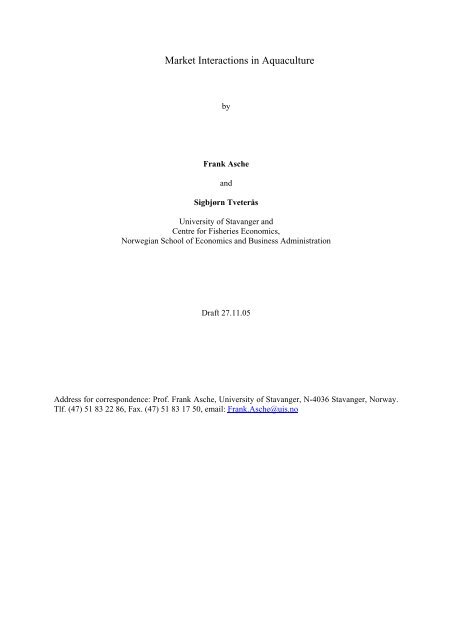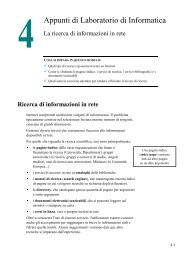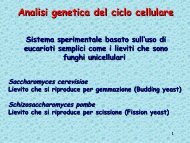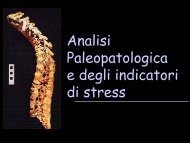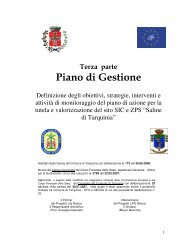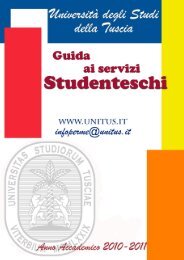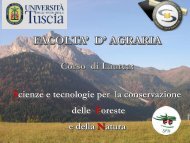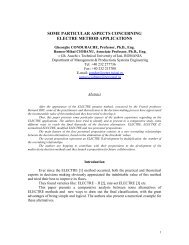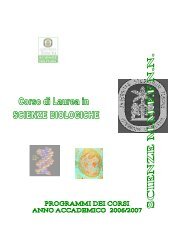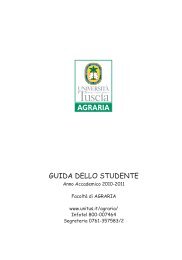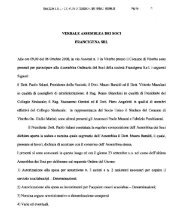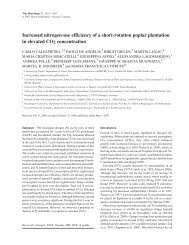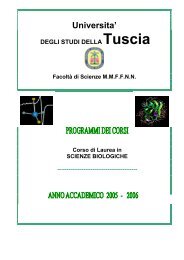Market Interactions in Aquaculture - ResearchGate
Market Interactions in Aquaculture - ResearchGate
Market Interactions in Aquaculture - ResearchGate
Create successful ePaper yourself
Turn your PDF publications into a flip-book with our unique Google optimized e-Paper software.
<strong>Market</strong> <strong>Interactions</strong> <strong>in</strong> <strong>Aquaculture</strong><br />
by<br />
Frank Asche<br />
and<br />
Sigbjørn Tveterås<br />
University of Stavanger and<br />
Centre for Fisheries Economics,<br />
Norwegian School of Economics and Bus<strong>in</strong>ess Adm<strong>in</strong>istration<br />
Draft 27.11.05<br />
Address for correspondence: Prof. Frank Asche, University of Stavanger, N-4036 Stavanger, Norway.<br />
Tlf. (47) 51 83 22 86, Fax. (47) 51 83 17 50, email: Frank.Asche@uis.no
<strong>Market</strong> <strong>in</strong>teractions for aquaculture products<br />
Abstract<br />
Dur<strong>in</strong>g the last two decades there has been a tremendous growth <strong>in</strong> the production of <strong>in</strong>tensively<br />
farmed fish. This growth has been accompanied by a substantial reduction <strong>in</strong> prices. As this enhances<br />
the competitiveness of farmed fish, concerns are often raised with respect to the market impact of new<br />
aquaculture species. Of particular <strong>in</strong>terest is the relationship to wild species <strong>in</strong> the output market as<br />
well as <strong>in</strong> the <strong>in</strong>put market because of the demand for feed. In this paper we <strong>in</strong>vestigate what we know<br />
about market <strong>in</strong>teractions based on two simple market models, where the difference between the two<br />
models is whether the compet<strong>in</strong>g product is wild caught seafood or a traditionally produced product.<br />
Keywords: <strong>Aquaculture</strong>, market <strong>in</strong>teraction, fishmeal trap
1. Introduction<br />
Dur<strong>in</strong>g the past 20 years new production technologies have allowed farmed fish to become an<br />
important segment of the world fish market. From 1970 production has <strong>in</strong>creased from about 3.5<br />
million tonnes to more than 50 million tonnes <strong>in</strong> 2003. Moreover, most of this growth is tak<strong>in</strong>g place <strong>in</strong><br />
the develop<strong>in</strong>g world as this makes up more then 80 percent of total production. At the same time,<br />
land<strong>in</strong>gs of wild fish have been stagnant while demand for fish and seafood has been perceived to<br />
<strong>in</strong>crease. Farmed seafood is now among the most important species <strong>in</strong> the largest seafood markets <strong>in</strong><br />
the world, the European Union, Japan and the United States (Anderson, 2002). Moreover, it is obvious<br />
that many of the new species are perceived to be competitors from the number of anti-dump<strong>in</strong>g and<br />
trade restrict<strong>in</strong>g measures that has been implemented. As such, it is clear that aquaculture products are<br />
perceived to be substitutes for wild caught seafood. At the same time, several authors have observed<br />
that several farmed species are us<strong>in</strong>g mar<strong>in</strong>e <strong>in</strong>puts as feed, and based on this fact, argues that<br />
<strong>in</strong>creased aquaculture production leads to <strong>in</strong>creased fish<strong>in</strong>g pressure for species that are used <strong>in</strong> the<br />
feed. This hypothesis is known as the fishmeal trap. Hence, aquaculture production also <strong>in</strong>teracts with<br />
wild stocks through the markets for its feed <strong>in</strong>puts.<br />
We will <strong>in</strong> this paper look at some of the impact of the additional supplies of farmed seafood on the<br />
world’s fish markets. Asche, Bjørndal and Young (2001) provide a number of hypotheses with respect<br />
to these potential <strong>in</strong>teractions. These are; a) <strong>in</strong>creased supplies of farmed fish depress the prices of<br />
wild-caught fish destroy<strong>in</strong>g fishermen’s livelihoods, 1 b) <strong>in</strong>creased supply of farmed fish is necessary<br />
to ma<strong>in</strong>ta<strong>in</strong> the supply of fish prote<strong>in</strong> as populations grow and land<strong>in</strong>gs are stagnat<strong>in</strong>g, c) farm<strong>in</strong>g<br />
enhances wild stocks as reduced prices lead to lower fish<strong>in</strong>g effort, d) farmed fish <strong>in</strong>crease the demand<br />
for fish <strong>in</strong> general as stable fish supplies with reliable quality also allow for more outlets with<br />
seasonally supplied wild fish. In addition, there is the hypothesis of the fishmeal trap. Depend<strong>in</strong>g on<br />
your stand, these hypotheses <strong>in</strong>dicate that <strong>in</strong>creased farmed seafood production may be positive or<br />
negative. Moreover, while the market impact from farmed fish is likely to be closest for “similar”<br />
species, it may also be important with respect to other types of fish and seafood products and different<br />
types of meat. Although many observers have been most concerned with the impact of farmed fish on<br />
wild caught fish, market structure is also important for the farmers. If their product competes <strong>in</strong> large<br />
market, <strong>in</strong>creased aquaculture production will have only a limited price effect. This may make it easier<br />
for the <strong>in</strong>dustry to grow than <strong>in</strong> the case where there are few or no substitutes, and the farmers have to<br />
create the market for their product. In addition there are a number of issues related to grow<strong>in</strong>g<br />
aquaculture production such as environmental issues and coastal use.<br />
In this paper the focus is on the market impact of farmed fish, or how the <strong>in</strong>creased supplies and<br />
reduced prices of farmed fish affect demand for potentially compet<strong>in</strong>g products. As these questions to<br />
a large extent are related to market structure, the discussion will ma<strong>in</strong>ly be about what is known about<br />
the market structure for these types of farmed fish. As noted by Anderson (1985), this problem<br />
becomes particularly <strong>in</strong>terest<strong>in</strong>g for a subset of the potentially compet<strong>in</strong>g goods, other fish. This is<br />
because the biological constra<strong>in</strong>t on the supply of wild caught fish makes the supply schedule for these<br />
products backward bend<strong>in</strong>g. However, s<strong>in</strong>ce land<strong>in</strong>gs of wild fish and fish farm<strong>in</strong>g are very different<br />
methods of produc<strong>in</strong>g fish, farmed fish will have a number of unique attributes compared to the wild<br />
caught fish even if the meat sold is largely the same. Our empirical examples will focus on salmon.<br />
This has two ma<strong>in</strong> reasons. The most important is that salmon is clearly the most studies seafood<br />
species when it comes to market knowledge. In fact, it is the only species where there is a substantial<br />
academic literature on this topic. Moreover, it is also <strong>in</strong> many ways the species for which most<br />
<strong>in</strong>novations have taken place technologically as well as market wise. Hence, salmon is the species<br />
which most likely has experienced most of the potential market <strong>in</strong>teractions that can take place.<br />
The paper is organised as follows: section 2 presents some background <strong>in</strong>formation on aquaculture. In<br />
section 3 a brief account of market <strong>in</strong>teractions, us<strong>in</strong>g a simple economic model is given, while<br />
methods for measur<strong>in</strong>g market <strong>in</strong>teraction are discussed <strong>in</strong> section 4. In section 5 market <strong>in</strong>teractions<br />
1 This hypothesis apparently led to riots <strong>in</strong> France <strong>in</strong> 1993-1994, see e.g. Peridy, Guillotreau and Bernard (2000).<br />
1
of the three groups of species are studied; this is followed <strong>in</strong> section 6 by a discussion of the fishmeal<br />
trap. In section 7 some conclud<strong>in</strong>g remarks are provided.<br />
2. <strong>Aquaculture</strong> production<br />
<strong>Aquaculture</strong> is an old production technology that can be dated back at least two millennia <strong>in</strong> Ch<strong>in</strong>a,<br />
and it has more than hundred years of history also <strong>in</strong> many other parts of the world. Depend<strong>in</strong>g on<br />
species and region, there is also a wide variety <strong>in</strong> production methods from fresh water ponds to<br />
mussel stakes. However, there are also several common features, which most easily can be described<br />
as very extensive production technologies. In most cases, f<strong>in</strong>gerl<strong>in</strong>gs, fries or small <strong>in</strong>dividuals are<br />
colleted from wild stocks, are placed <strong>in</strong> an environment where they can feed themselves, but where the<br />
farmer has sufficient control to be able to harvest them.<br />
Dur<strong>in</strong>g the last decades a revolution has taken place with respect to the production technology that is<br />
available <strong>in</strong> aquaculture, as semi-<strong>in</strong>tensive and <strong>in</strong>tensive production technologies has been <strong>in</strong>vented.<br />
This has led to a substantial <strong>in</strong>crease <strong>in</strong> production. In Figure 1 we show the total global seafood<br />
production from 1970 together with wild and aquaculture production. As can be seen, aquaculture was<br />
relatively <strong>in</strong>significant <strong>in</strong> 1970, mak<strong>in</strong>g up only about 5 percent of total seafood production with a<br />
production volume of about 3.5 million tons. In 2003 this had <strong>in</strong>creased to about 55 million tonnes so<br />
that aquaculture constitute about a third of the total seafood supply. Moreover, while land<strong>in</strong>gs of wild<br />
fish has been stagnant s<strong>in</strong>ce the late 1980s, aquaculture production has <strong>in</strong>creased so much that it more<br />
than makes up for this and <strong>in</strong> fact keep up the rate of <strong>in</strong>crease <strong>in</strong> the supply of seafood. Supply of<br />
seafood has been <strong>in</strong>creas<strong>in</strong>g more rapidly then the global population growth, so that per capita supply<br />
of seafood has <strong>in</strong>creased <strong>in</strong> all of the three previous decades. Hence, it is clear that aquaculture already<br />
plays a very important role <strong>in</strong> the global supply of food.<br />
Ch<strong>in</strong>a is clearly the largest aquaculture producer, with different species of carp and scallops, oysters<br />
and mussels as the most important product forms. However, although exports of tilapia and shrimps<br />
have become significant <strong>in</strong> recent years, most of the production is for domestic use. The same is true<br />
for much of the other low valued farmed seafood that is produced. We will here focus on the high<br />
valued species that are traded, with shrimp and salmon as the lead<strong>in</strong>g species. Shrimps and salmonides<br />
comb<strong>in</strong>ed makes up just about 5% of total production, but makes up as much as 20% of production<br />
value. Moreover, it is among the top five species consumed <strong>in</strong> the three ma<strong>in</strong> import markets, the EU,<br />
Japan and the US. These are the larges seafood markets <strong>in</strong> the world by value, and the targeted<br />
markets for many new aquaculture species.<br />
All successful new aquaculture species, when success is measures as a significant quantity produced,<br />
has at least one common feature. The price decl<strong>in</strong>es significantly as production <strong>in</strong>crease. This is only<br />
natural, as this is necessary to make the product competitive <strong>in</strong> the market. This is shown for shrimp <strong>in</strong><br />
Figure 2, and salmon <strong>in</strong> Figure 3. We will <strong>in</strong> the follow<strong>in</strong>g give some attention to salmon, to illustrate<br />
the mechanisms <strong>in</strong>volved.<br />
The term ‘farmed salmon’ refers to Atlantic salmon, coho and salmon trout, which are very similar<br />
species and seem to be highly substitutable. 2 Salmon is the most successful of the <strong>in</strong>tensively farmed<br />
species when measured by the quantity produced. Salmon aquaculture became commercially<br />
<strong>in</strong>terest<strong>in</strong>g <strong>in</strong> the early 1980s. From then on the availability of salmon <strong>in</strong>creased substantially. In 1980<br />
the total supply of salmon was about 500,000 tonnes, of which only 13,000 tonnes were farmed.<br />
Dur<strong>in</strong>g the 1980s the land<strong>in</strong>gs of wild Pacific salmon <strong>in</strong>creased substantially to historically high<br />
levels; <strong>in</strong> the 1990s, these have been about 800,000 tonnes, although with much variation. However,<br />
the most significant change <strong>in</strong> the salmon market is the huge <strong>in</strong>crease <strong>in</strong> the supply of farmed fish.<br />
From 13,000 tonnes <strong>in</strong> 1980 farmed production has <strong>in</strong>creased to about 1.4 million tonnes <strong>in</strong> 2004,<br />
mak<strong>in</strong>g the total supply of salmon over 2 million tonnes, or more than a quadrupl<strong>in</strong>g s<strong>in</strong>ce 1980.<br />
2 About 80% of the farmed salmon were Atlantic, and its share seems to be <strong>in</strong>creas<strong>in</strong>g. It should also be noted<br />
that <strong>in</strong> Canada about 10 000 tonnes of farmed ch<strong>in</strong>ook are produced each year.<br />
2
Figure 4 shows total aquaculture production, the real Norwegian export price and production cost. 3 It<br />
is evident that the <strong>in</strong>crease <strong>in</strong> production has been accompanied by a substantial reduction <strong>in</strong> prices; <strong>in</strong><br />
real terms, the price at the turn of the century was only one third that of 1982. However, production<br />
costs have also decl<strong>in</strong>ed, hence expansion has been possible because of substantial productivity<br />
growth (Asche, 1997). Although this suggests that a large part of the growth <strong>in</strong> salmon aquaculture<br />
has been a move down along the demand schedule, there is also evidence that this has been amplified<br />
by market growth, partly due to generic advertis<strong>in</strong>g programmes (Bjørndal, Salvanes and Andreassen,<br />
1992; K<strong>in</strong>nucan and Myrland, 1998). There is also a substantial productivity development tak<strong>in</strong>g place<br />
<strong>in</strong> the supply cha<strong>in</strong> as the predictability of the supply is much larger for farmed seafood. This is shown<br />
for catfish by Zidack, K<strong>in</strong>nucan and Hatch (1992). A measure that provides evidence with respect to<br />
the magnitude is that Norwegian salmon farmers are paid almost 50% of retail value for whole fresh<br />
salmon. For cod fishermen the same percentage is between 10 and 15%. The <strong>in</strong>creased share of<br />
retailed fish that is sold through supermarket cha<strong>in</strong>s (Murray and Fofana, 2002) is also beneficial to<br />
aquaculture with the higher degree of control <strong>in</strong> the supply cha<strong>in</strong>.<br />
It is also worthwhile not<strong>in</strong>g that farmed salmon is produced <strong>in</strong> large quantities <strong>in</strong> only a few countries.<br />
With their 2004-share <strong>in</strong> parenthesis, Norway (37%), Chile (36%), the UK (10%) and Canada (8%)<br />
make up more than 90% of the total quantity produced. Given that Canada and the UK are members of<br />
respectively NAFTA and the EU, this has lead to a number of trade conflicts (Asche, 1997, Anderson<br />
and Fong, 1998). The ma<strong>in</strong> target has been Norway, not surpris<strong>in</strong>gly given its dom<strong>in</strong>ant share of<br />
production, but recently Chilean producers have also been found guilty of dump<strong>in</strong>g <strong>in</strong> the US, and<br />
they also face penalties on their exports.<br />
3. Theory<br />
<strong>Market</strong> <strong>in</strong>teractions, such as the ones considered here, are the core of microeconomic theory. A<br />
formal, albeit simple model of market <strong>in</strong>teractions will be developed to highlight some of the<br />
relationships under <strong>in</strong>vestigation. In particular, an <strong>in</strong>terest<strong>in</strong>g relationship is due to the fact that an<br />
important subset of the potentially compet<strong>in</strong>g goods to farmed fish, captured fish, has a backward<br />
bend<strong>in</strong>g supply schedule (Anderson, 1985). Moreover, as many of the world’s fish stocks are reported<br />
to be fully or overexploited, it is likely that the market equilibrium for many of the world’s fish stocks<br />
is on the backward bend<strong>in</strong>g part of their supply schedule.<br />
Consider a very simple model with two goods, the aquaculture product and a potentially compet<strong>in</strong>g<br />
D<br />
product. Let qi<br />
be the quantity demanded, pi and p j the prices of the two products and I consumer<br />
expenditure or <strong>in</strong>come. The demand for the two products can be written as<br />
D<br />
i i i i j j +<br />
(1) q = a − b p + c p d I<br />
i<br />
where i=A and j=O if it is the demand for the aquaculture product, and i=O and j=A if it is the demand<br />
for the compet<strong>in</strong>g product. For the <strong>in</strong>teraction between farmed and other products the parameter c j is<br />
of key <strong>in</strong>terest, as this gives the strength of the substitution effect. In particular, if c j =0, there is no<br />
substitution effect and therefore no market <strong>in</strong>teraction.<br />
S<br />
i<br />
The supply of farmed fish, q , is a function of output price, pi, and <strong>in</strong>put price(s), w i , as is the supply<br />
of the compet<strong>in</strong>g product if it is a traditionally produced product. This can be written as<br />
3 The markets for different species and product forms of salmon seem to be highly <strong>in</strong>tegrated (Asche and<br />
Sebulonsen, 1998, Asche, Bremnes and Wessells (1999) and Asche (2000). Therefore, there should be no<br />
problem to <strong>in</strong>terpret the Norwegian export price as the global price of salmon.<br />
3
S<br />
(2) q i = mi<br />
+ ni<br />
pi<br />
+ oiwi<br />
The ma<strong>in</strong> cause for the <strong>in</strong>creased supply of farmed fish is productivity growth. This may take two<br />
forms, productivity growth <strong>in</strong> the farm<strong>in</strong>g operation and productivity growth for the suppliers of <strong>in</strong>put<br />
factors. 4 The first corresponds to a reduction of m i , while the second results <strong>in</strong> reduced <strong>in</strong>put price(s),<br />
w i . Productivity growth leads to a downward shift <strong>in</strong> the supply schedule.<br />
Possible market <strong>in</strong>teractions are illustrated <strong>in</strong> Figure 5, where demand and supply both for farmed fish<br />
and for a potentially compet<strong>in</strong>g product are shown. Assume that the prices are normalised so that they<br />
<strong>in</strong>itially are equal for the two products, and that the supply of farmed fish shifts downward due to<br />
productivity growth. This leads the supply of farmed fish to <strong>in</strong>crease from q1 to q1’ and the price to<br />
decrease from p1 to p1’. The effect on the market for the potentially compet<strong>in</strong>g product depends on<br />
the parameter c A <strong>in</strong> the demand equation for this good, s<strong>in</strong>ce this parameter determ<strong>in</strong>es the cross-price<br />
effect of the compet<strong>in</strong>g product with respect to a price change for farmed fish. If this parameter is<br />
zero, there will be no effect, price and quantity demanded rema<strong>in</strong>s at p2, q2, and there is no market<br />
<strong>in</strong>teraction. If the parameter is positive, imply<strong>in</strong>g substitutes, a price reduction for farmed fish will<br />
lead to a downward shift <strong>in</strong> the demand for the compet<strong>in</strong>g product. At most, the demand schedule for<br />
the compet<strong>in</strong>g product can shift down sufficiently for the relative price to rema<strong>in</strong> constant. This<br />
corresponds to the demand schedule D2’ <strong>in</strong> figure 5, with quantity demanded reduced to q2’ and price<br />
to p2’. If there is a weaker substitution effect, the demand schedule for this product will shift down to<br />
e.g. D2’’. This gives a reduction <strong>in</strong> price and demanded quantity, but the shift <strong>in</strong> demand is not<br />
sufficient to keep the relative price stable.<br />
If the compet<strong>in</strong>g product is a wild caught fish species, the supply will also be a function of the<br />
biological characteristics of the stock and/or the regulatory system. In open access equilibrium the<br />
supply schedule is backward bend<strong>in</strong>g. Us<strong>in</strong>g the same bioeconomic model as Anderson (1985), the<br />
supply of wild caught fish can then be written as<br />
S rC ⎛ C<br />
(3) ⎟ ⎞<br />
q = ⎜<br />
i<br />
1 −<br />
pi<br />
⎝ pi<br />
K ⎠<br />
where r is the <strong>in</strong>tr<strong>in</strong>sic growth rate of the fish stock, C is cost per unit of effort <strong>in</strong> the fishery and K is<br />
the environmental carry<strong>in</strong>g capacity for this fish stock. 5 If the fishery is managed with a quota, and <strong>in</strong><br />
most cases this is based on biological considerations only, this makes the supply schedule vertical.<br />
<strong>Market</strong> effects are illustrated <strong>in</strong> figure 6. Figure 6 differs from figure 5 <strong>in</strong> that that the supply schedule<br />
for the compet<strong>in</strong>g product, captured fish, is backward bend<strong>in</strong>g. If the fishery is on the upward bend<strong>in</strong>g<br />
part of the supply schedule, the description of the effects is as for a conventional product. The most<br />
<strong>in</strong>terest<strong>in</strong>g part is if the fishery is on the backward bend<strong>in</strong>g part of the supply schedule. This may also<br />
be most representative with regard to world fisheries, as a large number of wild fish stocks are<br />
overexploited (FAO, 2003).<br />
Assume aga<strong>in</strong> that productivity growth gives a downward shift <strong>in</strong> the supply schedule for farmed fish,<br />
reduc<strong>in</strong>g price to p1’ and <strong>in</strong>creas<strong>in</strong>g quantity supplied to q1’. The effect on the market for the<br />
potentially compet<strong>in</strong>g product aga<strong>in</strong> depends on the parameter c A , which determ<strong>in</strong>es the cross-price<br />
effect of the compet<strong>in</strong>g product with respect to a price change for farmed fish. As above, if this<br />
parameter is zero, there will be no effect, and therefore no market <strong>in</strong>teraction. If the parameter is<br />
4 A decomposition of productivity growth <strong>in</strong> salmon farm<strong>in</strong>g can be found <strong>in</strong> Tveterås (1999).<br />
5 See Anderson (1985) for a discussion of the underly<strong>in</strong>g bioeconomic model and the specific parameters.<br />
4
positive, imply<strong>in</strong>g substitutes, a price reduction for farmed fish will lead to a downward shift <strong>in</strong> the<br />
demand for the compet<strong>in</strong>g product. At most, the demand schedule for the compet<strong>in</strong>g product can shift<br />
down sufficiently for the relative price to rema<strong>in</strong> constant. This corresponds to the demand schedule<br />
D2’ <strong>in</strong> the figure, which implies that the quantity demanded of this good is <strong>in</strong>creased to q2’ while the<br />
price is reduced to p2’. If there is a weaker substitution effect, the demand schedule for this product<br />
will shift down to e.g. D2’’. This gives a reduction <strong>in</strong> price and an <strong>in</strong>crease <strong>in</strong> quantity, but the shift <strong>in</strong><br />
demand is not big enough to keep the relative price stable. The ma<strong>in</strong> difference from the case with a<br />
conventional product is the quantity effect for wild caught fish. When the price is reduced, this leads<br />
to lower fish<strong>in</strong>g effort, which gives a higher fish stock and higher land<strong>in</strong>gs.<br />
While one of the primary concerns with respect to market structure for farmed fish often is the effect<br />
of farmed fish on other products, it may also be worthwhile to comment upon the effect of the market<br />
structure for possible growth of aquaculture production. Let us look at conventional products first. If<br />
production of farmed fish is <strong>in</strong>creas<strong>in</strong>g relative to the other product, this implies that the productivity<br />
for farmed fish production <strong>in</strong>creases faster than for the other product. If the two products are close<br />
substitutes, farmed fish can then w<strong>in</strong> market shares from the other product. However, if the goods are<br />
not substitutes there are no market effects, and the <strong>in</strong>crease <strong>in</strong> the supply of the farmed fish will only<br />
lead to a move down the demand schedule for farmed fish. Hence, for the producers of farmed fish it is<br />
easier to expand when the farmed fish has substitutes with established markets. As observed by<br />
Anderson (1985), this situation changes if the potential substitute is fish from a fishery located on the<br />
backward bend<strong>in</strong>g part of the supply schedule. The <strong>in</strong>creased supply of farmed fish will then also lead<br />
to a higher supply of wild caught fish, lead<strong>in</strong>g to keener competition. Anderson also shows that <strong>in</strong><br />
some cases, this keener competition may drive the farmed fish producers out of bus<strong>in</strong>ess.<br />
No mention has been made of the possibility that farmed fish and other products may be<br />
complementary. This is mostly because it <strong>in</strong>creases the complexity of the model, as there always must<br />
be at least one substitute if there is any market <strong>in</strong>teraction on the demand side. However, even though<br />
complementarity is a possible effect, it is most likely not a very important effect.<br />
4. Test<strong>in</strong>g for <strong>Market</strong> <strong>Interactions</strong><br />
In general micro economic theory assumes that there exists a market place constituted by a group of<br />
commodities. The group of commodities compete <strong>in</strong> the same market because goods are substitutable<br />
for the consumer. Whether goods are substitutes, or not, can be measured by estimat<strong>in</strong>g demand<br />
equations to test whether there are cross-price effects (Triff<strong>in</strong>, 1940). If there are, the goods compete <strong>in</strong><br />
the same market, while if there are not, the goods do not compete. The most common measure of a<br />
cross-price effect is a cross-price elasticity. The most common research approach is demand analysis,<br />
where demand equations are estimated either <strong>in</strong>dividually or <strong>in</strong> a system of demand equations. These<br />
studies of the demand structure focus on the price sensitivity of demand, on the degree of substitution<br />
between potentially compet<strong>in</strong>g products and on <strong>in</strong>come/expenditure effects.<br />
A common problem is obta<strong>in</strong><strong>in</strong>g the necessary data to estimate demand equations. Often price data<br />
are available but not quantity. Moreover, while one can often f<strong>in</strong>d a price that is a good proxy for<br />
market price, it is hard to get reliable estimates of demand equations if data are not available for the<br />
full quantity consumed <strong>in</strong> a market at different price levels. This has also led to markets be<strong>in</strong>g def<strong>in</strong>ed<br />
only based on price <strong>in</strong>formation. For <strong>in</strong>stance, Stigler def<strong>in</strong>es a market as:<br />
“the area with<strong>in</strong> which the price of a commodity tends to uniformity, allowance be<strong>in</strong>g made for<br />
transportation costs” (Stigler, 1969)<br />
When look<strong>in</strong>g at figure 5, the <strong>in</strong>tuition beh<strong>in</strong>d this k<strong>in</strong>d of def<strong>in</strong>ition can be seen by look<strong>in</strong>g at the<br />
effect of shifts <strong>in</strong> supply and demand schedules from the price differential. When the supply curve for<br />
farmed fish shifts, the price changes. This can then have three types of effects on the price of the other<br />
good. If there is no substitution effect, the demand schedule does not shift and there is no movement <strong>in</strong><br />
price. If there is a substitution effect, the demand schedule shifts, and the price shifts <strong>in</strong> the same<br />
direction as the price of farmed fish. At most, the price of the other product can shift by the same<br />
5
percentage as the price of farmed fish, mak<strong>in</strong>g the relative price constant so that the Law of One Price<br />
(LOP) holds.<br />
Hence there are at least two ways of test<strong>in</strong>g for market <strong>in</strong>tegration, or if two or more products are<br />
substitutes. One is to estimate the demand function for a product and to test for cross-price effects.<br />
Alternatively, one can look at the effects only <strong>in</strong> the price differential, where one can test whether<br />
there is a price effect (i.e., substitution), and if the relative price is constant, i.e., whether the Law of<br />
One Price (LOP) holds.<br />
If consideration is given to the four hypotheses about the impact of farmed fish on wild fish, demand<br />
<strong>in</strong>teractions are sufficient to <strong>in</strong>vestigate some but not all aspects of these hypotheses. In particular, it<br />
gives all the <strong>in</strong>formation one needs to evaluate hypothesis a, whether <strong>in</strong>creased supplies of farmed fish<br />
leads to reduced prices of wild fish, and hypothesis d, whether farmed fish <strong>in</strong>crease fish demand <strong>in</strong><br />
general. Hypothesis a will be true if there is a substitution effect between farmed and wild fish. To test<br />
hypothesis d, there must be at least three goods <strong>in</strong> the model, because <strong>in</strong> the two goods case the<br />
products must be substitutes. However, if farmed fish and wild fish are complements, hypothesis d<br />
will hold. For farmed fish to enhance wild stocks, i.e. hypothesis c, it must be the case that farmed and<br />
wild fish are substitutes. However, although this is necessary, it is not sufficient, s<strong>in</strong>ce the effect will<br />
depend on the regulatory system. Knowledge about demand <strong>in</strong>teraction will not shed light on<br />
hypothesis b, that <strong>in</strong>creased supply of farmed fish is necessary to ma<strong>in</strong>ta<strong>in</strong> the supply of fish prote<strong>in</strong>.<br />
5. <strong>Market</strong> <strong>in</strong>teraction<br />
There are substantial differences with respect to knowledge about market <strong>in</strong>teraction for different<br />
species. A number of studies of salmon markets have been conducted and there is also a body of<br />
literature for catfish, but very little for sea bass, sea bream and <strong>in</strong>deed other farmed species.<br />
Knowledge about market <strong>in</strong>teraction between farmed fish and other species is therefore to a large<br />
extent dependant on what we know about market structure for salmon.<br />
The demand for salmon has often been modelled with different product forms of salmon other fish<br />
species, and meats as potential substitutes. These studies <strong>in</strong>clude Bjørndal et al., (1992), DeVoretz and<br />
Salvanes (1993), Herrmann et al., (1993), Wessells and Wilen (1993, 1994), Bjørndal et al., (1994),<br />
Asche (1996, 1997b), Asche and Hannesson (1997), Asche et al., (1997), Eales et al., (1997), Salvanes<br />
and DeVoretz (1997), Asche et al., (1998), Johnson et al., (1998), K<strong>in</strong>nucan and Myrland (1998),<br />
Eales and Wessells (1999), Steen and Salvanes (1999) and Asche and Steen (2000). In addition, a<br />
several studies have <strong>in</strong>vestigated <strong>in</strong>teraction between prices. These <strong>in</strong>clude Gordon et al., (1993),<br />
Asche et al., (1997), Asche and Sebulonsen (1998), Asche et al., (1999), Clayton and Gordon (1999),<br />
Asche (2000) and Jaffry et al. (2000), Asche et al. (2002), Virtanen et al. (2005), Asche et al. (2005).<br />
The results can be divided <strong>in</strong>to three groups: <strong>in</strong>teractions between different species and product forms<br />
of salmon, <strong>in</strong>teractions between salmon and other seafood and f<strong>in</strong>ally, <strong>in</strong>teraction between salmon and<br />
meat.<br />
For different salmon species and product forms of salmon the results <strong>in</strong>dicate that these are close<br />
substitutes. In particular, where tested, the Law of One Price holds, <strong>in</strong>dicat<strong>in</strong>g that relative prices are<br />
stable. Hence, <strong>in</strong>creased production of farmed salmon has had a substantial impact on the markets and<br />
prices for wild Pacific salmon. One could <strong>in</strong>terpret the <strong>in</strong>creased supplies of Pacific salmon as<br />
evidence that one has moved down along a backward bend<strong>in</strong>g supply schedule and that salmon<br />
farm<strong>in</strong>g therefore has been beneficial for wild salmon stocks. However, several factors cast doubts<br />
with respect to such an <strong>in</strong>terpretation. As noted above, the land<strong>in</strong>gs are now at historically high levels,<br />
so if one is mov<strong>in</strong>g down the supply schedule this must have had a substantial outward shift. This may<br />
be the case s<strong>in</strong>ce substantial hatch<strong>in</strong>g programmes were implemented <strong>in</strong> the 1980s (Boyce et al, 1993).<br />
But these programmes may also be the underly<strong>in</strong>g cause for the <strong>in</strong>creased land<strong>in</strong>gs and hence,<br />
although number of fishermen and their revenues have decreased, salmon farm<strong>in</strong>g may not have had<br />
any impact on land<strong>in</strong>gs. This is likely due to the regulatory structure, because <strong>in</strong> regulated open access<br />
fisheries substantial overcapacity will tend to emerge (Homans and Wilen, 1997). In such fisheries<br />
6
educed revenues will reduce the overcapacity but as long as overcapacity persists, it will have little<br />
effect on land<strong>in</strong>gs.<br />
For other species, there is some evidence that salmon competes with high-valued fish, and also a<br />
greater range of fish <strong>in</strong> Japan. However, salmon does not <strong>in</strong> general seem to compete with big volume<br />
species of fish as <strong>in</strong> the global whitefish market. Furthermore, the results from Japan are often for the<br />
period prior to the substantial <strong>in</strong>crease <strong>in</strong> the supply of farmed salmon. Hence, these results are based<br />
mostly on lower valued wild species which are sold, at least partly, <strong>in</strong> product forms that farmed<br />
salmon are not used for. While these results may seem surpris<strong>in</strong>g, there are good reasons that this is<br />
the case. In particular, salmon is sold mostly as fresh or smoked, which are product forms that are not<br />
very common for most wild caught species. Furthermore, farmed salmon is not sold as fish f<strong>in</strong>gers,<br />
frozen blocks and many other product forms that are important for many wild species, and particularly<br />
for big volume species. A somewhat surpris<strong>in</strong>g result is reported <strong>in</strong> Asche and Steen (2000), <strong>in</strong> that<br />
they f<strong>in</strong>d evidence of several fish species <strong>in</strong> the EU be<strong>in</strong>g complements for salmon, imply<strong>in</strong>g that the<br />
expansion <strong>in</strong> the salmon market has made more room for other species as well. Although it is possible<br />
that the <strong>in</strong>creased availability of salmon may make it easier to sell other fish, and market<strong>in</strong>g<br />
campaigns for salmon may spill over to other fish, at least <strong>in</strong> some market segments, it seems less<br />
plausible that this is generally the case.<br />
There is little knowledge about any possible relationship between salmon and meats. In general the<br />
evidence <strong>in</strong>dicates no <strong>in</strong>teraction. However some evidence from more recent years <strong>in</strong> Japan may<br />
present a possible exception; Eales and Wessells (1999) provide evidence of a shift from no<br />
<strong>in</strong>teraction to some competition <strong>in</strong> the mid-1990s.<br />
Most studies on the demand structure for catfish have been primarily <strong>in</strong>terested <strong>in</strong> the effect of generic<br />
market<strong>in</strong>g programmes. However, as part of the evaluation process, demand equations are estimated.<br />
These studies <strong>in</strong>clude K<strong>in</strong>nucan and Venkateswaran (1990), K<strong>in</strong>nucan and Thomas (1997) and<br />
K<strong>in</strong>nucan and Miao (1999). Meat product like poultry have been tested as substitutes, without f<strong>in</strong>d<strong>in</strong>g<br />
any evidence that these products are compet<strong>in</strong>g with catfish. In unpublished work no relationship<br />
between an <strong>in</strong>dex of fish prices and the demand for catfish has been found. 6 However, <strong>in</strong> recent years<br />
imports of catfish have <strong>in</strong>creased and this fish has been found to be a substitute to the US raised<br />
catfish (K<strong>in</strong>nucan and Miao, 1999).<br />
Literature searches suggest that the only study test<strong>in</strong>g the market structure for sea bass and sea bream<br />
is Asche and Steen (1998). They <strong>in</strong>vestigated the relationship between the price of sea bass/sea bream<br />
and a number of other fish species <strong>in</strong> the EU, and found that sea bass/sea bream may compete with<br />
portion trout and several white fish species. However, there are some problems with the time series<br />
properties of the sea bass/sea bream data as they are very close to be<strong>in</strong>g stationary. These results do<br />
not make too much sense s<strong>in</strong>ce sea bass/sea bream are consumed to a very limited extent <strong>in</strong> the areas<br />
where these compet<strong>in</strong>g species are consumed and vice versa. It is therefore likely that these results<br />
<strong>in</strong>dicate that sea bass/sea bream are stationary and that there is no relationship between sea bass/sea<br />
bream and these other species.<br />
With the exception of the close relationship between different salmon species, the ma<strong>in</strong> conclusion<br />
seems to be that there is little market <strong>in</strong>teraction between farmed fish and other products,<br />
<strong>in</strong>dependently of whether these products are other fish or meats. Generalisation from this result would<br />
seem to <strong>in</strong>dicate that a farmed species competes ma<strong>in</strong>ly with the same wild species (and other species<br />
<strong>in</strong> the same segment), and not with other species. Some support for this view can be found <strong>in</strong> the<br />
results of most demand studies of seafood products, s<strong>in</strong>ce it is <strong>in</strong>dicated that the seafood market is<br />
highly segmented. Still, s<strong>in</strong>ce the production of the farmed species makes up substantial quantities and<br />
there obviously is demand for the fish, they must w<strong>in</strong> market share somewhere. It may, of course, be<br />
that the data or tools are not good enough to detect the relationships, or possibly that the appropriate<br />
goods as potential substitutes have yet to be tested. However, it seems more plausible that farmed fish<br />
6 Personal communication, Henry K<strong>in</strong>nucan.<br />
7
partly creates new market segments and partly w<strong>in</strong>s market share from such a large varieties of goods<br />
that the effects are too small to pick up for any one good <strong>in</strong> isolation. Some further explanation may lie<br />
<strong>in</strong> consider<strong>in</strong>g the key characteristic differences of the cultured and captured products with particular<br />
focus upon their perceived value <strong>in</strong> the value cha<strong>in</strong>.<br />
7. The Fishmeal Trap<br />
The ‘fishmeal trap’ is the name of a hypothesis that claims that aquaculture is environmental<br />
degrad<strong>in</strong>g because it leads to <strong>in</strong>creased fish<strong>in</strong>g effort to satisfy <strong>in</strong>creased demand for feed (Naylor et<br />
al). Moreover, it follows that the availability of mar<strong>in</strong>e feed will put a limit to how much the<br />
aquaculture sector can produce. While the fishmeal trap is mentioned <strong>in</strong> relation to aquaculture <strong>in</strong><br />
general, it is clear that it is an issue only <strong>in</strong> some forms of f<strong>in</strong>fish farm<strong>in</strong>g, and does not apply to<br />
farm<strong>in</strong>g of sea weeds and mussels. Furthermore, it will only apply to species that are fed with feed<br />
us<strong>in</strong>g mar<strong>in</strong>e <strong>in</strong>puts. This is a substantial part of the sector, as this is the case not only for carnivorous<br />
species like salmon and sea bass, but also for omni- or herbivorous species because the use of feed<br />
<strong>in</strong>creases the growth rate. There are, however, some conditions that must be fulfilled for the fishmeal<br />
trap to occur. In this section this will be discussed follow<strong>in</strong>g Asche and Tveterås (2004).<br />
To what extent the fishmeal trap associated with aquaculture growth represents an environmental<br />
problem can be decomposed <strong>in</strong>to two key issues, one perta<strong>in</strong><strong>in</strong>g to the regulation of capture fisheries<br />
and one perta<strong>in</strong><strong>in</strong>g to the market for prote<strong>in</strong> meals. To what extent <strong>in</strong>creas<strong>in</strong>g demand for fishmeal<br />
<strong>in</strong>creases fish<strong>in</strong>g effort is related to the management regime <strong>in</strong> operation for the fishery <strong>in</strong> question.<br />
Hence, whether growth of aquaculture production can lead to unsusta<strong>in</strong>able capture fisheries is<br />
primarily a fisheries management problem. However, as the track record of many fisheries<br />
management systems is not too good, this can be a real problem. It does, however, require that<br />
aquaculture growth <strong>in</strong>crease total demand for fishmeal.<br />
To what extent <strong>in</strong>creas<strong>in</strong>g aquaculture production <strong>in</strong>creases fish<strong>in</strong>g pressure depends on whether there<br />
are substitutes for fishmeal. There is little doubt that the markets for fishmeal are global. In fact, this is<br />
a ma<strong>in</strong> part of the criticism aga<strong>in</strong>st the aquaculture <strong>in</strong>dustry, as it is the prime example that negative<br />
environmental effects are global and not only local. The aquaculture <strong>in</strong>dustry is, however, far from the<br />
only consumer of fishmeal. Pig and poultry jo<strong>in</strong>tly consume 53 percent of the production, while the<br />
aquaculture share is 35 percent. Moreover, for most of the species that use fishmeal as feed, this is<br />
only one part of their diet. Other prote<strong>in</strong> meals, with soyameal as the most important meal, make up<br />
the major share of the diet. If one looks at the total market for prote<strong>in</strong> meals <strong>in</strong> Figure 7, global<br />
fishmeal production is m<strong>in</strong>or compared to the total prote<strong>in</strong> meal production.<br />
When look<strong>in</strong>g closer at the development of fishmeal use, one can also question whether aquaculture’s<br />
share still really is <strong>in</strong>creas<strong>in</strong>g. In table 1, total availability of fishmeal as provided by Anderson and<br />
Kristofferson (2006) is shown, which as is well known is relatively stable but cyclical, world<br />
aquaculture production of f<strong>in</strong>fish and shrimp, their use of aquafeeds and the share of fishmeal go<strong>in</strong>g to<br />
aquafeed. It is clear that the quantity of fishmeal go<strong>in</strong>g to aquafeed was strongly <strong>in</strong>creas<strong>in</strong>g until 1997.<br />
However, after that it has stabilised at between 2 and 2.5 million tons. Still, aquaculture production<br />
cont<strong>in</strong>ues to <strong>in</strong>crease. Hence, it is far from obvious that there is a close l<strong>in</strong>k between aquaculture<br />
production of the species that are thought to be most dependent on fishmeal, and fishmeal use.<br />
There are two ma<strong>in</strong> explanations why fishmeal is used <strong>in</strong> livestock production. One explanation<br />
stresses the uniqueness of fishmeal. Fishmeal has higher prote<strong>in</strong> content than the other prote<strong>in</strong> meals,<br />
and also has a different nutritional structure. In particular, this is the case with respect to am<strong>in</strong>o acids<br />
that may be positive for the growth and general health of the animals. If fishmeal is unique, <strong>in</strong>creased<br />
demand from aquaculture production for fishmeal are likely to <strong>in</strong>crease prices, and therefore <strong>in</strong>crease<br />
fish<strong>in</strong>g pressure after poorly managed fish stocks. This might be true even if aquaculture’s share of the<br />
demand is only 35%, s<strong>in</strong>ce the additional demand from aquaculture then has to be met partly by<br />
aquaculture tak<strong>in</strong>g over fishmeal from other consumers that f<strong>in</strong>d it too expensive and partly because<br />
the higher price <strong>in</strong>creases production. The other explanation emphasizes that fishmeal <strong>in</strong> general is<br />
cheap prote<strong>in</strong>. If fishmeal primarily were demanded because it is cheap prote<strong>in</strong>, one would expect a<br />
8
high degree of substitutability between fishmeal and other prote<strong>in</strong> meals. These two explanations have<br />
very different implications for the price formation process for fishmeal. If fishmeal is used because it<br />
is unique, the price of fishmeal should be determ<strong>in</strong>ed by the demand and supply for fishmeal alone.<br />
However, if fishmeal is a close substitute for other prote<strong>in</strong> meals, one would not expect the price of<br />
fishmeal to be much <strong>in</strong>fluenced by <strong>in</strong>creased demand from aquaculture, s<strong>in</strong>ce the price is determ<strong>in</strong>ed<br />
by total demand for prote<strong>in</strong> meals. If so, <strong>in</strong>creased demand from aquaculture is not a threat to wild<br />
stocks.<br />
Fisheries Management<br />
There are a number of management forms <strong>in</strong> the world’s fisheries, but we can group them <strong>in</strong> three<br />
ma<strong>in</strong> groups: open access, sole-owner (or optimal management), and restricted open access (where the<br />
stock is protected with a quota and potentially additional measures. To what extent <strong>in</strong>creased demand<br />
will <strong>in</strong>crease fish<strong>in</strong>g pressure depends on the management regime.<br />
The world’s reduction fisheries are ma<strong>in</strong>ly based on fisheries for small pelagic species. 7 Pelagic fish<br />
are used both for human consumption and for reduction, i.e. fishmeal and fish oil, but certa<strong>in</strong> species<br />
are only fit for reduction due to their consistency, often be<strong>in</strong>g small, bony, and oily. Normal annual<br />
catches <strong>in</strong> the 1990s with the ma<strong>in</strong> purpose of reduction to fishmeal amount to approximately 30<br />
million MT (metric tonnes), giv<strong>in</strong>g an average of 6-7 million MT fishmeal. Chile and Peru alone<br />
deliver over 50% of the global fishmeal production based on their rich fisheries of Peruvian anchoveta,<br />
Chilean jack mackerel, and South American pilchard. Other substantial producers are the Nordic<br />
countries Denmark, Iceland and Norway. Comb<strong>in</strong>ed, their fisheries provide the basis for 15% of the<br />
global fishmeal production.<br />
A characteristic of the pelagic fisheries is that while the quantity go<strong>in</strong>g directly to human consumption<br />
stays relatively stable, the “surplus” that goes to reduction can vary dramatically (Hempel, 1999).<br />
Thus, <strong>in</strong> years when the catches are low, such as <strong>in</strong> El Niño periods, the fishmeal <strong>in</strong>dustry is hard<br />
struck. The pelagic fisheries have also generally been described as fully exploited or over-exploited by<br />
the FAO (Gra<strong>in</strong>ger and Garcia, 1996). A significant expansion of the global fishmeal production,<br />
beyond the 6-7 million MT that is normally produced, is therefore not likely unless prices for fishmeal<br />
<strong>in</strong>crease substantially.<br />
In the case with optimal management, the size of the land<strong>in</strong>gs responds to the <strong>in</strong>creased prices. The<br />
biomass will, however, always be higher than the biomass associated with Maximum Susta<strong>in</strong>able<br />
Yield (MSY). One can therefore hardly argue that the fishery poses a threat to the stock under optimal<br />
management. If the fishery is regulated by a quota that is set without pay<strong>in</strong>g attention to economic<br />
factors, the quota rema<strong>in</strong>s the same when demand changes, the biomass rema<strong>in</strong>s the same, but the<br />
value of the catch <strong>in</strong>creases. The obvious conclusion is that if the fishery is not allowed to respond to<br />
economic <strong>in</strong>centives, the <strong>in</strong>creased demand for reduction species will not have much effect other than<br />
e.g. depress<strong>in</strong>g season length.<br />
Accord<strong>in</strong>gly, the real problem is <strong>in</strong> the open access scenario, s<strong>in</strong>ce <strong>in</strong>creased demand for a species <strong>in</strong><br />
this scenario might lead to serious depletion of the stock, and will <strong>in</strong>crease the risk of ext<strong>in</strong>ction. The<br />
model outl<strong>in</strong>ed here allows the stock to be driven down to very low levels, although not to become<br />
ext<strong>in</strong>ct. It is clear, however, that with very low stock levels, the species also become substantially<br />
more vulnerable to changes <strong>in</strong> other factor like water temperature, sal<strong>in</strong>ity, etc. that are not accounted<br />
for <strong>in</strong> the model. In more general models, one may also <strong>in</strong>crease the probability for ext<strong>in</strong>ction.<br />
How is then the management situation for the most important stocks used <strong>in</strong> <strong>in</strong>dustrial fisheries? The<br />
stocks of Peruvian anchoveta and Chilean jack mackerel have shown vulnerability both to the weather<br />
phenomenon El Niño and because of poor fisheries management. The fisheries management has,<br />
however, improved over the last decade, with <strong>in</strong>creas<strong>in</strong>gly stricter regulations on <strong>in</strong>puts. The most<br />
7 Pelagic fish are free migrat<strong>in</strong>g fish species that <strong>in</strong>habit the surface waters, as opposed to demersal fish that<br />
<strong>in</strong>habits the sea floor.<br />
9
important tools used <strong>in</strong> Chile and Peru today are TACs, limited access, <strong>in</strong>put factor regulations and<br />
closures that are imposed on the fisheries <strong>in</strong> certa<strong>in</strong> periods and certa<strong>in</strong> areas.<br />
The <strong>in</strong>dustrial fisheries <strong>in</strong> the Nordic countries are regulated by TACs, often <strong>in</strong> comb<strong>in</strong>ation with other<br />
restrictions. In the late 1960s and early 1970s, the herr<strong>in</strong>g stock collapsed, but the overall state of the<br />
fisheries for reduction <strong>in</strong> the Nordic countries has improved, and several of these stocks have been<br />
rebuilt to the levels before the collapses. In the US, the menhaden fishery is the ma<strong>in</strong> <strong>in</strong>dustrial<br />
fishery, and also here the fishery is regulated with a TAC.<br />
A first glance may <strong>in</strong>dicate that the management situations for the most important pelagic fisheries are<br />
not too bad, and that open access is not a correct description. However, quotas tend to be high and one<br />
may often question whether the state of the fish stocks has the ma<strong>in</strong> priority when the quotas are set.<br />
Hence, it is not clear that the situation is very different from what it would be under open access.<br />
Whether <strong>in</strong>creased demand for fishmeal from a grow<strong>in</strong>g aquaculture <strong>in</strong>dustry is harmful for the state<br />
of the fish stocks that are targeted <strong>in</strong> <strong>in</strong>dustrial fisheries will thus to a large extent depend on the<br />
market structure for fishmeal.<br />
The <strong>Market</strong> for Oil Meals<br />
We now turn to the market for fishmeal. We need to def<strong>in</strong>e the market, s<strong>in</strong>ce the extent of the market<br />
by far determ<strong>in</strong>es whether <strong>in</strong>creased demand from aquaculture affect prices with poor management of<br />
the stocks with the current management practices. To determ<strong>in</strong>e the position of fishmeal <strong>in</strong> the prote<strong>in</strong><br />
meal market, Asche and Tveterås (2004) <strong>in</strong>vestigated its relationship to soyameal, s<strong>in</strong>ce soyameal<br />
clearly is the largest of the vegetable meals. Their procedure was to analyse the relationships prices<br />
from Europe and USA provided by IFOMA (1998), <strong>in</strong> the period from January 1981 to April 1999.<br />
The European prices are reported from Hamburg, and are denoted as Fish Ham and Soya Ham. In<br />
addition, they use fishmeal prices from Atlanta, Georgia, denoted as Fish_Atl, and soyameal prices<br />
reported from Decatur, Ill<strong>in</strong>ois, denoted as Soya_Dec. The prices are shown <strong>in</strong> Figure 8. Note that the<br />
fishmeal prices are substantially higher than the soyameal prices. This is primarily because of the<br />
higher prote<strong>in</strong> content. If one adjusts for the prote<strong>in</strong> content, most of the difference disappears. The<br />
period chosen is <strong>in</strong>terest<strong>in</strong>g for at least two reasons. First, there have been some extreme situations for<br />
fishmeal production <strong>in</strong> this period due to low raw material supply, <strong>in</strong>clud<strong>in</strong>g El Niños <strong>in</strong> 1982-83,<br />
1986-88, 1991-92 and <strong>in</strong> 1997-98, with the first and the last be<strong>in</strong>g the most severe. This makes it<br />
<strong>in</strong>terest<strong>in</strong>g to compare how fishmeal and soyameal markets have <strong>in</strong>teracted dur<strong>in</strong>g these extreme<br />
periods. Second, this is the period when most of the growth <strong>in</strong> <strong>in</strong>tensive aquaculture has taken place. If<br />
the fishmeal primarily is demanded due to its special attributes, this should show up as the fishmeal<br />
and soyameal be<strong>in</strong>g different market segments dur<strong>in</strong>g this period.<br />
The results suggest that the markets for fishmeal and soyameal are highly <strong>in</strong>tegrated and accord<strong>in</strong>gly<br />
that the two products are strong substitutes. Total demand for fish and soyameal, possibly together<br />
with the demand for other prote<strong>in</strong> meals, thus determ<strong>in</strong>es the price of these prote<strong>in</strong> meals. If<br />
aquaculture is to <strong>in</strong>fluence the price of fishmeal with this market structure, the changes <strong>in</strong> demand or<br />
supply must be large enough to affect demand and supply for fish- and soyameal comb<strong>in</strong>ed. It is,<br />
however, unlikely that <strong>in</strong>creased demand for fishmeal from the aquaculture sector will lead to<br />
<strong>in</strong>creased prices for fishmeal, s<strong>in</strong>ce it has only a negligible share of the market. It is also unlikely that<br />
<strong>in</strong>creased demand for fishmeal from the aquaculture sector <strong>in</strong>crease fish<strong>in</strong>g pressure <strong>in</strong> <strong>in</strong>dustrial<br />
fisheries.<br />
To conclude, <strong>in</strong>creased demand for fishmeal from a grow<strong>in</strong>g aquaculture sector has the potential to<br />
<strong>in</strong>crease fish<strong>in</strong>g pressure <strong>in</strong> <strong>in</strong>dustrial fisheries. It does, however, require that the fisheries are poorly<br />
managed (or not managed at all) and that there are no close substitutes to fishmeal. The most<br />
important fish stocks <strong>in</strong> reduction fisheries can be described as regulated open access. If this<br />
management regime is efficient, <strong>in</strong>creased demand from aquaculture does not pose a threat to the fish<br />
stocks. There are, however, many <strong>in</strong>dications that quotas are set higher then biological<br />
recommendations and that quotas might be overfished. With such a situation one might not be too far<br />
from open access. If so, <strong>in</strong>creased demand for fishmeal may well <strong>in</strong>crease fish<strong>in</strong>g pressure.<br />
10
Poor fisheries management does not cause <strong>in</strong>creased fish<strong>in</strong>g pressure alone. In addition, there cannot<br />
be any close substitutes to fishmeal, s<strong>in</strong>ce close substitutes would alleviate the pressure on the<br />
fishmeal market and consequently the fisheries. Asche and Tveterås (2004) <strong>in</strong>dicate that fishmeal is<br />
part of the large prote<strong>in</strong> meal market, and, <strong>in</strong> particular, that fishmeal is a close substitute to soyameal.<br />
With such market structure it is total supply and demand for prote<strong>in</strong> meals, of which fishmeal makes<br />
up only 4%, which determ<strong>in</strong>es prices for fishmeal. One is then led to the conclusion that <strong>in</strong>creased<br />
demand for fishmeal from aquaculture cannot have had any significant impact on fishmeal prices <strong>in</strong><br />
the long run, and accord<strong>in</strong>gly not led to <strong>in</strong>creased fish<strong>in</strong>g pressure. However, demand for fishmeal<br />
from aquaculture has grown from basically noth<strong>in</strong>g to 35 percent of total production <strong>in</strong> only twenty<br />
years. If demand for fishmeal from the aquaculture sector cont<strong>in</strong>ues to grow it is possible that the<br />
market structure may change. However, this does not have to be the case, s<strong>in</strong>ce it is not clear that even<br />
the demand for fishmeal from the aquaculture sector is ma<strong>in</strong>ly because of the unique characteristics of<br />
fishmeal. What is clear though is that the current market structure prevents <strong>in</strong>creased demand for<br />
fishmeal to have a negative impact on <strong>in</strong>dustrial fish stocks. Moreover, as the productivity growth a<br />
lower production costs has been the ma<strong>in</strong> eng<strong>in</strong>e <strong>in</strong> the growth of the aquaculture sector, <strong>in</strong>creased<br />
prices that will follow if there is a shortage of fishmeal and oil will reduce demand. However, the only<br />
measure that can ensure that demand for fishmeal does not have a negative impact on these fish stocks<br />
due to <strong>in</strong>creased fish<strong>in</strong>g pressure at any time <strong>in</strong> the future is good fisheries management.<br />
7. Conclud<strong>in</strong>g remarks<br />
In this paper we look at the market <strong>in</strong>teractions of farmed seafood <strong>in</strong> the output as well as the <strong>in</strong>put<br />
market. The strong reduction <strong>in</strong> the price for new aquaculture species gives an <strong>in</strong>dication that the<br />
markets for these species are not strongly l<strong>in</strong>ked to the markets for other products. S<strong>in</strong>ce few if any<br />
other goods can show a similar development <strong>in</strong> prices, the relative price between farmed fish and most<br />
other goods have changed substantially. As perfect substitutes have a constant relative price and close<br />
substitutes have highly correlated prices, this is an <strong>in</strong>dication that farmed fish does not compete too<br />
closely with other goods. The limited knowledge we have about the market structure for these species<br />
also <strong>in</strong>dicates that market <strong>in</strong>teractions between farmed fish and other fish and meat are very limited<br />
with the exception of the wild supplies of the species that are farmed. However, s<strong>in</strong>ce the production<br />
of these farmed species makes up substantial quantities and there obviously is demand for the fish, it<br />
must w<strong>in</strong> market share somewhere. We th<strong>in</strong>k it is difficult to f<strong>in</strong>d where farmed fish w<strong>in</strong> market shares<br />
because farmed fish partly creates new market segments and partly w<strong>in</strong>s market share from such a<br />
large variety of goods that the effects are too small to pick up for each good.<br />
There are many possible reasons why new aquaculture products should not <strong>in</strong>teract too much with<br />
traditional market segments. Most of these are related to unique attributes of the farmed fish. In<br />
particular, relative to other species, and particularly big volume species, a very large share of the<br />
farmed fish is sold <strong>in</strong> fresh product forms. This is possible because the higher degree of control of the<br />
production process gives the farmers the opportunity to decide when to market their product. This<br />
allows a supply cha<strong>in</strong> very different from that of wild caught fish. The changes <strong>in</strong> food distribution<br />
and the retail sector are a further advantage for farmed fish relative to captured supplies, s<strong>in</strong>ce farmed<br />
production is much better suited to this k<strong>in</strong>d of supply cha<strong>in</strong> than land<strong>in</strong>gs from traditional fisheries.<br />
F<strong>in</strong>ally, there is little evidence that the fishmeal trap hypothesis has any validity. While it is not<br />
rendered <strong>in</strong>valid of the most obvious reason, that good fisheries management is prevent<strong>in</strong>g<br />
overfish<strong>in</strong>g, it seems to be <strong>in</strong>valid because of market <strong>in</strong>teractions. In particular, fishmeal seems to be a<br />
part of the much larger market for vegetabile meals. Furthermore, cost considerations, which is<br />
necessary for aquacultured products to stay competitive, makes it impossible for aquaculture<br />
producers to significantly <strong>in</strong>crease demand for fishmeal by bidd<strong>in</strong>g up the price.<br />
11
References<br />
Anderson, J. L. (1985) "<strong>Market</strong> <strong>Interactions</strong> Between <strong>Aquaculture</strong> and the Common-Property<br />
Commercial Fishery," Mar<strong>in</strong>e Resource Economics, 2, 1-24.<br />
Anderson, J. L. (2000) "<strong>Aquaculture</strong> and the Future." Mar<strong>in</strong>e Resource Economics 17, 133-152.<br />
Anderson, J. L., and Q. S. W. Fong (1997) "<strong>Aquaculture</strong> and International Trade," <strong>Aquaculture</strong><br />
Economics and Management, 1, 29-44.<br />
Anderson, J. L and D. Kristofferson (2006) " Is there a Relationship between Fisheries and Farm<strong>in</strong>g?<br />
Interdependence of Fisheries, Animal Production and <strong>Aquaculture</strong> " Forthcomm<strong>in</strong>g <strong>in</strong> Mar<strong>in</strong>e<br />
Policy.<br />
Asche, F. (1996) "A System Approach to the Demand for Salmon <strong>in</strong> the European Union," Applied<br />
Economics, 28, 97-101.<br />
Asche, F. (1997a) "Trade Disputes and Productivity Ga<strong>in</strong>s: The Curse of Farmed Salmon<br />
Production?," Mar<strong>in</strong>e Resource Economics, 12, 67-73.<br />
Asche, F. (1997b) "Dynamic Adjustment <strong>in</strong> Demand Equations," Mar<strong>in</strong>e Resource Economics, 12,<br />
221-237.<br />
Asche, F., T. Bjørndal, and K. G. Salvanes (1998) "The Demand for Salmon <strong>in</strong> the European Union:<br />
The Importance of Product Form and Orig<strong>in</strong>," Canadian Journal of Agricultural Economics, 46,<br />
69-82.<br />
Asche, F., H. Bremnes, and C. R. Wessells (1999) "Product Aggregation, <strong>Market</strong> Integration and<br />
Relationships Between Prices: An Application to World Salmon <strong>Market</strong>s," American Journal of<br />
Agricultural Economics, 81, 568-581.<br />
Asche, F., A. G. Guttormsen, and R. Tveteras (1999) "Environmental Problems, Productivity and<br />
Innovations <strong>in</strong> Norwegian Salmon <strong>Aquaculture</strong>," Aquacultural Economics and Management, 3,<br />
19-30.<br />
Asche, F, A. G. Guttormsen, T. Sebulonsen and E. H. Sissener (2005) Competition between farmed<br />
and wild salmon: The Japanese salmon market. Agricultural Economics, 33, 333-340.<br />
Asche, F., D. V. Gordon and R. Hannesson (2002) ”Search<strong>in</strong>g for Price Parity <strong>in</strong> the European<br />
Whitefish <strong>Market</strong>” Applied Economics, 34, 1017-1024.<br />
Asche, F., K. G. Salvanes, and F. Steen (1997) "<strong>Market</strong> Del<strong>in</strong>eation and Demand Structure," American<br />
Journal of Agricultural Economics, 79, 139-150.<br />
Asche, F., and T. Sebulonsen (1998) "Salmon Prices <strong>in</strong> France and the UK: Does Orig<strong>in</strong> or <strong>Market</strong><br />
Place Matter?," <strong>Aquaculture</strong> Economics and Management, 2, 21-30.<br />
Asche, F., and F. Steen (1998) "The EU - one or several fish markets: An aggregated market<br />
del<strong>in</strong>eation study of the EU fish market," SNF-Report 61/98.<br />
Asche, F. (2000) "Test<strong>in</strong>g the effect of an anti-dump<strong>in</strong>g duty: The US salmon market," Empirical<br />
Economics, 26, 343-355.<br />
Asche, F., T. Bjørndal, and J. A. Young (2001) "<strong>Market</strong> <strong>Interactions</strong> for <strong>Aquaculture</strong> Products."<br />
<strong>Aquaculture</strong> Economics and Management 5, 303-318.<br />
Asche, F., and S. Tveterås (2004) "On the Relationship between <strong>Aquaculture</strong> and Reduction<br />
Fisheries." Journal of Agricultural Economics 55, 245-265.<br />
Bjørndal, T., D. V. Gordon, and K. G. Salvanes (1994) "Elasticity Estimates of Farmed Salmon<br />
Demand <strong>in</strong> Spa<strong>in</strong> and Italy," Empirical Economics, 4, 419-428.<br />
Bjørndal, T., K. G. Salvanes, and J. H. Andreassen (1992) "The Demand for Salmon <strong>in</strong> France: the<br />
Effects of <strong>Market</strong><strong>in</strong>g and Structural Change," Applied Economics, 24, 1027-1034.<br />
Boyce, J., M. Herrmann, D. Bischak, and J. Greenberg (1993) "The Alaska Salmon Enhancement<br />
Program: A Cost/Benefit Analysis," Mar<strong>in</strong>e Resource Economics, 8, 293-312.<br />
Clayton, P. L., and D. V. Gordon (1999) "From Atlantic to Pacific: Price L<strong>in</strong>ks <strong>in</strong> the US Wild and<br />
Farmed Salmon <strong>Market</strong>," <strong>Aquaculture</strong> Economics and Management, 3, 93-104.<br />
Devoretz, D. J., and K. G. Salvanes (1993) "<strong>Market</strong> Structure for Farmed Salmon," American Journal<br />
of Agricultural Economics, 75, 227-233.<br />
Eales, J., C. Durham, and C. R. Wessells (1997) "Generalized Models of Japanese Demand for Fish,"<br />
American Journal of Agricultural Economics, 79, 1153-1163.<br />
Eales, J., and C. R. Wessells (1999) "Test<strong>in</strong>g Separability of Japanese Demand for Meat and Fish<br />
with<strong>in</strong> Differential Demand Systems," Journal of Agricultural and Resource Economics, 24,<br />
114-126.<br />
12
FAO (2003). The State of World Fisheries and <strong>Aquaculture</strong> 2003. Rome: Food and Agriculture<br />
Organisation of the United Nations.<br />
Gordon, D. V., K. G. Salvanes, and F. Atk<strong>in</strong>s (1993) "A Fish Is a Fish Is a Fish: Test<strong>in</strong>g for <strong>Market</strong><br />
L<strong>in</strong>kage on the Paris Fish <strong>Market</strong>," Mar<strong>in</strong>e Resource Economics, 8, 331-343.<br />
Guillotreau, P. (1998) Foreign Trade and Seafood Prices: Implications for the CFP. F<strong>in</strong>al Report. Len-<br />
Corrail, Nantes.<br />
Herrmann, M. L., R. C. Mittelhammer, and B. H. L<strong>in</strong> (1993) "Import Demand for Norwegian Farmed<br />
Atlantic Salmon and Wild Pacific Salmon <strong>in</strong> North America, Japan and the EC," Canadian<br />
Journal of Agricultural Economics, 41, 111-125.<br />
Homans, F. R., and J. E. Wilen (1997) "A Model of Regulated Open Access Resource Use," Journal<br />
of Environmental Economics and Management, 32, 1-21.<br />
Jaffry, S., S. Pascoe, G. Taylor, and U. Zabala (2000a) "Price <strong>in</strong>teractions between salmon and wild<br />
caught fish species on the Spanish market," <strong>Aquaculture</strong> Economics and Management, 4, 157-<br />
168.<br />
Johnson, A., C. A. Durham, and C. R. Wessells (1998) "Seasonality <strong>in</strong> Japanese Household Demand<br />
for Meat and Seafood," Agribus<strong>in</strong>ess, 14, 337-351.<br />
K<strong>in</strong>nucan, H. (1995) "Catfish <strong>Aquaculture</strong> <strong>in</strong> the United States: Five Propositions about <strong>in</strong>dustry<br />
growth and policy," World <strong>Aquaculture</strong>, 26, 13-20.<br />
K<strong>in</strong>nucan, H. W., and Y. Miao (1999) "Media-Specific Returns to Generic Advertis<strong>in</strong>g: The Case of<br />
Catfish," Agribus<strong>in</strong>ess, 15, 81-99.<br />
K<strong>in</strong>nucan, H. W., and Ø. Myrland (1998) “Optimal Advertis<strong>in</strong>g Levies with Application to the<br />
Norway-EU” pp 701 711, In A. Eide and T. Vassdal (eds.) IIFET 98 Proceed<strong>in</strong>gs, University of<br />
Tromsø, Tromsø.<br />
K<strong>in</strong>nucan, H. W., S. S<strong>in</strong>delar, D. W<strong>in</strong>eholt, and U. Hatch (1988) "Processor Demand and Price-<br />
Markup Functions for Catfish," Southern Journal of Agricultural Economics, 20, 81-91.<br />
K<strong>in</strong>nucan, H. W., and M. Thomas (1997) "Optimal Media Allocation Decisions for Generic<br />
Advertiser," Journal of Agricultural Economics, 48, 425-441.<br />
K<strong>in</strong>nucan, H. W., and M. Venkateswaran (1990) "Effects of Generic Advertis<strong>in</strong> on Perceptions and<br />
Behavior: The Case of Catfish," Southern Journal of Agricultural Economics, 22, 137-152.<br />
Murray, A. D., and A. Fofana. (2002) "The Chang<strong>in</strong>g Nature of UK Fish Retail<strong>in</strong>g." Mar<strong>in</strong>e Resource<br />
Economics 17, 335-340.<br />
Naylor, R. L., et al. (2000) "Effects of <strong>Aquaculture</strong> on World Fish Supplies." Nature 405, 1017-1024.<br />
Peridy, N., P. Guillotreau, and P. Bernard (2000) "The Impact of Prices of Seafood Trade: A Panel<br />
Data Analysis of the French Seafood <strong>Market</strong>," Mar<strong>in</strong>e Resource Economics, 15, 45-66.<br />
Salvanes, K. G., and D. J. DeVoretz (1997) "Household Demand for Fish and Meat Products:<br />
Separability and Demographic Effects," Mar<strong>in</strong>e Resource Economics, 12, 37-55.<br />
Steen, F., and K. G. Salvanes (1999) "Test<strong>in</strong>g for market power us<strong>in</strong>g a dynamic oligopoly model."<br />
International Journal of Industrial Organization 17, 147-177.<br />
Stigler, G. J. The Theory of Price. London: Macmillan, 1969.<br />
Triff<strong>in</strong>, R. (1940) Monopolistic Competition and General Equilibrium Theory. Cambridge, MA:<br />
Harvard University Press.<br />
Tveterås, R. (1999) "Production Risk and Productivity Growth: Some F<strong>in</strong>d<strong>in</strong>gs for Norwegian Salmon<br />
<strong>Aquaculture</strong>," Journal of Productivity Analysis, 12, 161-179.<br />
Virtanen, J., et al. (2005) "F<strong>in</strong>nish Salmon Trout - Discrim<strong>in</strong>ated <strong>in</strong> the European <strong>Market</strong>." Mar<strong>in</strong>e<br />
Resource Economics 20, 113-119.<br />
Wessells, C. R., R. J. Johnston, and H. Donath (1999) "Asses<strong>in</strong>g Consumer Preferences for Ecolabeled<br />
Seafood: The Influence of Species, Certifier and Household Attributes," American Journal of<br />
Agricultural Economics, 81, 1084-1089.<br />
Wessells, C. R., and J. E. Wilen (1993) "Economic Analysis of Japanese Household Demand for<br />
Salmon," Journal of the World <strong>Aquaculture</strong> Society, 24, 361-378.<br />
Wessells, C. R., and J. E. Wilen (1994) "Seasonal Patterns and Regional Preferences <strong>in</strong> Japanese<br />
Household Demand for Seafood," Canadian Journal of Agricultural Economics, 42, 87-103.<br />
Zidack, W., H. W. K<strong>in</strong>nucan, and U. Hatch (1992) "Wholesale- and Farm-level impacts of Generic<br />
Advertis<strong>in</strong>g: The Case of Catfish," Applied Economics, 24, 959-968.<br />
13
Table 1<br />
World aquaculture production of f<strong>in</strong>fish and shrimp <strong>in</strong> millions of metric tonnes (MMT), the<br />
production of fishmeal and the use of fishmeal <strong>in</strong> aquafeed<br />
Year Fishmeal Reference<br />
World<br />
aquaculture<br />
production 1<br />
MMT 2<br />
World<br />
fishmeal<br />
production 3<br />
MMT<br />
Use <strong>in</strong> aquafeed<br />
use % of<br />
MMT WP<br />
1988 8.20 6.85 0.69 10.1% New, Shehadeh & Ped<strong>in</strong>i (1995)<br />
1992 10.90 6.25 0.96 15.4% New and Wijkström (2002)<br />
1994 14.06 7.48 1.27 17.0% Pike (1998)<br />
1995 16.10 6.85 1.73 25.2% Tacon (1998)<br />
1996 18.04 6.92 2.00 28.9% Tacon (1999)<br />
1997 19.97 6.54 2.32 35.5% Tacon (1999)<br />
1998 21.24 5.33 2.13 39.9% IFOMA<br />
1999 23.09 6.66 2.10 31.6% IFOMA<br />
2000 24.57 7.04 2.46 34.9% Pike and Barlow (2002)<br />
2001 26.36 6.22 2.49 40.0% Pike and Barlow (2002)<br />
2002 27.94 6.48 2.22 34.2% Barlow (2003)<br />
2003 29.83 5.58 2.00 35.8% GAFTA – 2004<br />
1 World production of f<strong>in</strong>fish and crustaceans FISHSTAT, FAO 2004.<br />
2 Million metric tonnes<br />
3 World production of fishmeal FISHSTAT, FAO 2004.<br />
14
160<br />
140<br />
120<br />
Total<br />
<strong>Aquaculture</strong><br />
Wild<br />
100<br />
80<br />
60<br />
40<br />
20<br />
0<br />
1970<br />
1972<br />
1974<br />
1976<br />
1978<br />
1980<br />
1982<br />
1984<br />
1986<br />
1988<br />
1990<br />
1992<br />
1994<br />
1996<br />
1998<br />
2000<br />
Mill. tons<br />
Figure 1. Global production of seafood, wild and aquaculture<br />
15
2500<br />
2000<br />
1500<br />
Wild<br />
Farmed<br />
Total<br />
1000<br />
500<br />
0<br />
1980<br />
1982<br />
1984<br />
1986<br />
1988<br />
1990<br />
1992<br />
1994<br />
1996<br />
1998<br />
Figure 2. Global supply of salmon, 1980-1999<br />
16
12<br />
10<br />
Price<br />
Quantity<br />
2 000<br />
1 800<br />
1 600<br />
USD/kg<br />
8<br />
6<br />
4<br />
1 400<br />
1 200<br />
1 000<br />
800<br />
600<br />
1000 tons<br />
2<br />
400<br />
200<br />
0<br />
-<br />
1984<br />
1986<br />
1988<br />
1990<br />
1992<br />
1994<br />
1996<br />
1998<br />
2000<br />
2002<br />
Figure 2. Global aquaculture production of shrimp and real price (2003=1)<br />
17
9<br />
8<br />
7<br />
Price<br />
Quantity<br />
1600<br />
1400<br />
1200<br />
GBP/kg<br />
6<br />
5<br />
4<br />
3<br />
1000<br />
800<br />
600<br />
1000 tons<br />
2<br />
400<br />
1<br />
200<br />
0<br />
0<br />
81<br />
83<br />
85<br />
87<br />
89<br />
91<br />
93<br />
95<br />
97<br />
99<br />
2001<br />
3<br />
Figure 3. Global aquaculture production of Atlantic salmon and real price (2003=1)<br />
18
NOK/kg<br />
90<br />
80<br />
70<br />
60<br />
50<br />
40<br />
30<br />
20<br />
10<br />
0<br />
Cost<br />
Price<br />
1985<br />
1987<br />
1989<br />
1991<br />
1993<br />
1995<br />
1997<br />
1999<br />
2001<br />
Figure 4. Real production cost and producer price pr. Kg <strong>in</strong> NOK 1985-2002 (2002=1)<br />
19
Figure 5. Potential market <strong>in</strong>teraction between farmed fish and traditional goods<br />
20
Figure 6. Potential market <strong>in</strong>teraction between farmed fish and wildcaught fish<br />
21
Other meals<br />
17 %<br />
Corn meals<br />
(a)<br />
9 %<br />
Fish meal<br />
4 %<br />
Soybean<br />
meal<br />
53 %<br />
Rape & Sun<br />
(b)<br />
17 %<br />
Figure 7. World production of prote<strong>in</strong> meals 1996/97 (OW, 1999)<br />
(a) Corngerm and cornglutenfeed. (b) Rapeseed meal and sunflower seed meal<br />
22
800<br />
700<br />
600<br />
500<br />
400<br />
300<br />
200<br />
100<br />
0<br />
81-01<br />
82-01<br />
83-01<br />
84-01<br />
85-01<br />
86-01<br />
87-01<br />
88-01<br />
89-01<br />
90-01<br />
91-01<br />
92-01<br />
93-01<br />
94-01<br />
95-01<br />
96-01<br />
97-01<br />
98-01<br />
99-01<br />
USD per tonne<br />
Fish_Ham<br />
Soya_Ham<br />
Fish_Atl<br />
Soya_Dec<br />
Figure 8. Monthly fishmeal and soybean meal price data from Hamburg (Ham), Atlanta (Atl) and<br />
Decatur (Dec) <strong>in</strong> the period of January 1981 to April 1999 (IFFO, 2000)<br />
23


